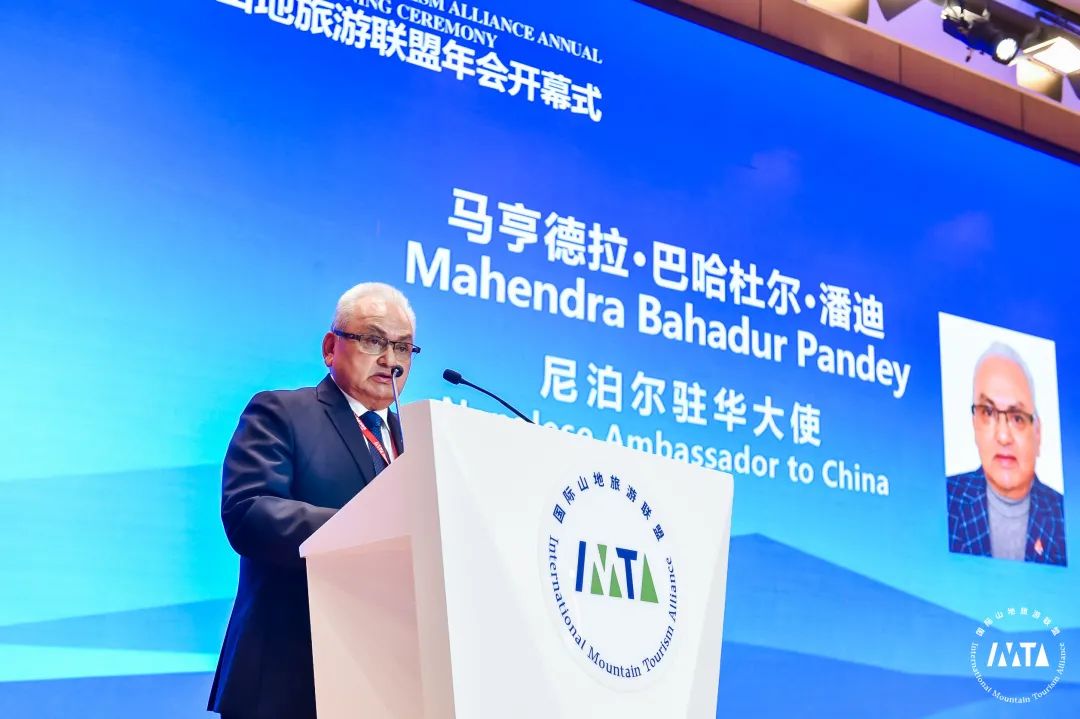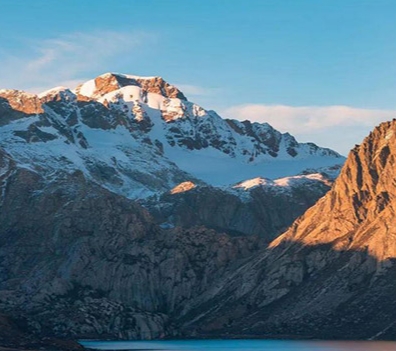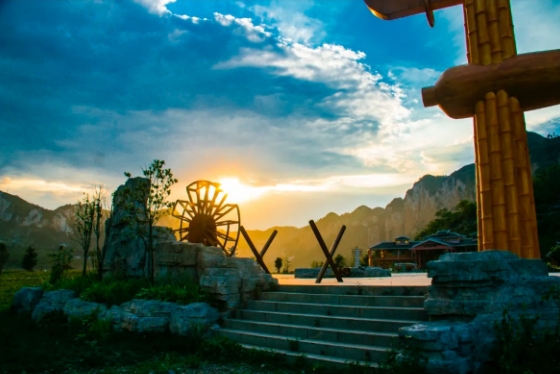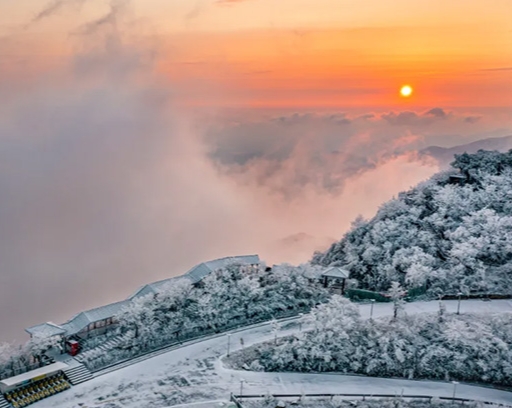11月17-19日,2020国际山地旅游联盟年会顺利召开。本届年会以“后疫情时代国际山地旅游发展之路”为主题,采取现场与线上直播、场内与场外互动相结合的创新方式,举办开幕式暨主题论坛、2020“世界名山对话”、企业家座谈会、“世界名山与贵州山地旅游对话”摄影展、“8·9·00”思享会等具有创新意义的活动,同步在Facebook、Twitter、新浪新闻等多家国内外新媒体平台进行直播。
本届年会得到了世界旅游组织(UNWTO)、世界旅游及旅行业理事会(WTTC)、亚太旅游协会(PATA)、世界旅游经济论坛(GTEF)、世界旅游联盟(WTA)、世界旅游城市联合会(WTCF)、中国-东盟中心等众多国际组织鼎力支持。
尼泊尔驻华大使
马亨德拉·巴哈杜尔·潘迪的致辞

女士们、先生们,
首先,我对于来到贵州省贵阳这个美丽的城市参加2020国际山地旅游联盟年会感到非常的荣幸。在面临新冠肺炎疫情带来的诸多挑战之际,能够来到山地乐土贵州参加这次会议显得尤为特别。我对主办方主办这次活动表示衷心的感谢和赞赏,并向在座的各位致以亲切的问候和良好的祝愿。
亲爱的朋友们,
在尼泊尔147181平方公里的陆地总面积中,有四分之三以上是山地景观,其中就包括喜马拉雅山脉。如大家所知,喜马拉雅山有着原始的自然和文化景观。在3500平方公里的兴都库什山脉中,尼泊尔的喜马拉雅山脉占地面积约800平方公里,包括约1800座山峰。其中1300多座山峰海拔高度达6000米以上。除了喜马拉雅山脉,尼泊尔境内还有一些其他山脉:西瓦利克山脉、摩诃婆罗多山脉和中部山区(Mid hills)。在这些山脉之间,岭谷纵横交错,居住着种群众多的居民。
原始的喜马拉雅山脉是世界著名的山地旅游胜地。尼泊尔境内被联合国教科文组织列为世界遗产的7处文化遗产和1处自然遗产均位于山地地区。这些山地旅游景观是宝贵的世界财富,我们需要竭尽全力为子孙后代保护它们。
尼泊尔有很多山地旅游景观:白雪皑皑的喜马拉雅山脉、深邃的峡谷、优美的乡村风光、森林、野生动物和鸟类、凉爽的气候条件、传统文化、节日和宗教场所。山地地区是河流、溪流和湖泊的淡水来源,同时也是可再生能源的来源,事实上,还被当地居民奉为神明。
这些景观使尼泊尔成为吸引世界各地游客的山地旅游胜地。而反过来,到尼泊尔旅游的游客也会在山地地区尝试各种各样的活动,包括徒步旅行和远足、生态旅游,以及各种探险活动。其中包括陆地旅游(徒步旅行、登山、骑马、极限跳伞、攀岩、观鸟)、空中旅游(蹦极、热气球、滑翔伞、超轻型飞机、山地飞行、缆车)和水上旅游(漂流、皮划艇、划船、钓鱼、游泳)。前往尼泊尔旅游的游客定然会带着与大自然亲密融合的美好回忆回到家中。
因此,尼泊尔的山地地区拥有巨大的山地旅游潜力,并且吸引了来自世界各地的人们。此外,旅游业还通过为当地居民提供就业机会和为政府储备外币收入,为山地经济作出了宝贵贡献。同样,旅游业也促进了各经济部门之间的生产开发和供应联系。然而,旅游业也面临着诸多挑战:我们需要加强山地旅游与社区旅游的联系,利用当地资源和当地产品,并增进山地人民的就业。
近年来,气候变化对山地地区脆弱的生态系统以及薄弱的基础设施造成越来越大的影响,因此,我们需要共同努力以应对其不利影响。由于山地地区人口的快速增长和经济机会的匮乏,自然环境正在迅速恶化。气候是山地旅游的一项重要属性,气候变化将通过影响各项设施和旅游目的地的整体可持续性直接对旅游业造成损害。这些影响可能表现为自然灾害增加,对当地人和游客健康的不利影响,以及对当地生态系统生物多样性的破坏。消除对于能源和交通类基础设施的破坏,并扭转自然资源的损耗和枯竭需要时间和大量的资源。在尼泊尔,一些不利影响可能表现为高山雪崩、冰川湖溃决、暴雪和山体滑坡,以及随之而来的一系列问题,如公路和徒步路线阻塞。
气候变化将对山地地区居民的生计产生重大影响,因此,我们必须强化缓解和适应措施。由于旅游业贯穿着经济的诸多层面,因此,将缓解和适应战略视为一项涵盖各个利益相关方的协作项目是非常重要的。这些利益相关方包括当地企业家以及卫生、交通运输和防灾备灾类非旅游机构等。
要缓解气候变化的不利影响,不仅要在山地地区周围,而且要在全球范围内,进行深刻的系统性改革。值得庆幸的是,国际社会已经意识到了气候变化的威胁,包括《巴黎气候协定》在内的联合国框架下的多项倡议都已处于各个实施阶段。而对于山地地区这个特殊的环境,则应毫不迟延地采取一些适应性措施。
这些适应性措施包括将旅游活动尽可能转移到低风险地区,安装防护措施(尤其是在陡峭地区和降雪量较大地区),通过预警系统培养对突发性灾难事件的响应能力,并建立完善的搜救站。同样,建立救助救援机制、保护缓冲林和其他保护性土地使用功能将有助于当地居民适应不断变化的环境。
尊敬的各位来宾,女士们、先生们,
与尼泊尔一样,贵州也是一个有着悠久历史的山地地区,且以其传统的乡村生态友好型生活方式而闻名。迷人的黄果树瀑布和安顺龙宫洞是大自然馈赠给贵州的珍贵礼物。而贵州人民与自然的和谐相处则是现代文明建设的典范。毫无疑问,贵州是举办山地旅游年会的理想地点。我相信这次年会将为我们所有人提供一次绝佳的机会,来共同讨论如何在我们各自的国家进一步推广山地旅游和户外运动。
正如我们所看到的,尼泊尔和中国的贵州省在山地旅游方面有着相似的潜力,并吸引着世界各地喜爱亲近自然且与自然和谐相处的游客。然而,尼泊尔和中国的贵州省在保护脆弱的山地生态系统和维护旅游产品的可持续性方面也面临着相似的挑战。我们在这里可以与其他山地国家携手并行,加强知识和技术分享方面的协调合作,以确保我们所有人都能够拥有光明的未来。我向各位保证,尼泊尔愿意成为这项联合倡议的一份子。
尊敬的各位来宾,女士们、先生们,
尼泊尔和中国是彼此信赖的朋友、近邻和可靠的发展伙伴。多年来,尼中两国关系在共同关心的各个领域不断加强,这令人十分满意。过去一年,我们在进一步加强互利关系方面取得了重要成果。总统级互访以及双边关系向战略合作伙伴关系的提升巩固和深化了两国关系。我们期待着进一步加强两国合作,共同抗击疫情,并进一步促进尼中两国在共同关心的各个领域的友好合作。
新冠肺炎疫情突显了各国,尤其是发展中国家在卫生、信息、通信和技术基础设施方面的严重缺陷和广泛差距。在此次疫情期间,建立各国之间的互联互通显然非常重要,这不仅有助于释放合作潜力,而且有助于共同应对全球性挑战。“一带一路”倡议是促进互利合作的一个良好范例。我相信,“一带一路”倡议可以将世界各国人民联系起来,从而在解决这些差距方面发挥重要作用。“健康丝绸之路”和“数字丝绸之路”计划等硬性基础设施和软性基础设施建设倡议,是如何利用“一带一路”倡议实现互利共赢,尤其是在应对全球性共同威胁方面的范例。
最后,我要再次向主办方主办这次有益的年会表示祝贺。这次会议使山地旅游业的重要利益相关方和参与者能够汇聚一堂,并为我们提供了一次绝佳的机会来分享我们在促进各自国家的山地旅游方面,尤其是在应对气候变化的影响方面的经验。我还要向贵州和本次会议的主办方致以最良好的祝愿,祝贺贵州努力发展成为著名的山地旅游胜地,并预祝本次会议圆满成功。
谢谢大家!

以下为英文全文
The Following is the Full Text in English
Ladies and Gentlemen,
Let me first express my great happiness to be here at this beautiful city of Guiyang in the Province of Guizhou to attend the 2020 Annual Conference of the International Mountain Tourism Alliance. It is even more special to come to Guizhou, a mountain paradise, to participate in this conference amidst the challenges wrought by the coronavirus pandemic. I express my sincere thanks and appreciation to the organizers for hosting this event, and express my warm greetings and good wishes to all those present here.
Dear Friends,
More than three-fourth of Nepal’s total landmass of 1,47,181 sq. km is covered with mountain landscapes, including the Himalayas. As you know, the Himalayan mountain range is endowed with pristine nature and culture. Of the 3500 sq. km Hindu-Kush range, Nepal’s Himalayas cover around 800 sq. km, with around 1800 mountain peaks. More than 1300 of these mountain peaks are above 6000 meters. Apart from the Himalayas, there are other mountain ranges in Nepal: the Sivaliks, Mahabharata, and mid hills. These mountain ranges are crisscrossed by valleys in between and are inhabited by various communities of people.
The pristine Himalayan range is a world famous destination for mountain tourism. The seven cultural heritage sites and one natural heritage site listed in UNESCO’s world heritage sites in Nepal are all located in the mountains. These mountain tourism sites are valuable world assets, and we need to do all we can to preserve and protect them for posterity.
The attractions of mountain tourism in Nepal are many: snowcapped great Himalayan ranges, deep gorges, beautiful landscapes, forests, wild animals and birds, cool climatic conditions, traditional culture, festivals, and religious places of worship. The mountains are sources of fresh water in the form of rivers, streams and lakes, as well as of renewable energy, and are in fact revered by the local communities as gods.
Such attractions make Nepal a fascinating mountain tourism destination for people from around the world. The tourists visiting Nepal, in turn, find a great variety of things to do in the mountains in the fields of trekking and expedition, ecotourism, and adventure sports. These include terrestrial tourism (trekking, mountaineering, pony trekking, ski diving, rock climbing, bird watching), aerial tourism (bungee jumping, hot air ballooning, paragliding, ultra-light aircraft, mountain flight, cable car), and aquatic tourism (rafting, kayaking, boating, fishing, swimming). Truly, a tourist visiting Nepal returns home with fond memories of his deep intimacy and immersion with nature.
Thus, Nepal’s mountains have immense mountain tourism potentials, and attracted people from far and wide. In addition, tourism has also made valuable contribution to the mountain economy by providing employment to the local people and foreign currency earnings to the government’s reserves. Similarly, it has induced production development and supply linkages across various sectors of the economy. However, there are challenges: we need to enhance the linkages of mountain tourism with community tourism, using local resources and making use of local products and enhancing employment for the people living in the mountains.
In recent years, climate change is exerting an increasingly greater impact on the fragile ecosystems of the mountains and their weak infrastructures, necessitating collective efforts to combat its adverse effects. With the rapid growth of population and lack of economic opportunities in the mountains, the natural environment is deteriorating rapidly. Since climate is an important attribute of mountain tourism, climate change can hit tourism directly by affecting the overall sustainability of facilities and destinations. These impacts may take the form of an increase in natural hazards, adverse impacts on health of the local and visiting people, and damage in the bio-diversity of the local ecologies. It takes time and resources to reverse the disruptions in energy and transport related infrastructures, and damage and depletion of the natural resource base. In Nepal, some of these impacts could take the form of high mountain avalanches, glacial lake outbursts, heavy snowfalls and landslides, with an array of attendant problems such as blockages of highways and trekking routes.
Thus, climate change will have major impacts on the livelihoods of the mountain populations, and it is essential for us to emphasize mitigation and adaptation measures. Since tourism transcends many aspects of the economy, it is important to view mitigation and adaptation strategies as a collaborative effort encompassing the relevant stakeholders, such as local entrepreneurs, non-tourism agencies related to health, transportation and disaster preparedness.
Mitigation of the adverse impacts of climate change will require a deep systemic overhaul, not just around the locations of the mountains but across the globe. Thankfully, the world community is aware of its dangers, and several initiatives under the UN, including the Paris Climate Agreement, are under various phases of implementation. In the specific context of mountains, however, there are several adaptive measures that should be taken up without any further delay.
Adaptive measures include relocation of tourism activities, where possible, to low-risk areas, installing protection measures especially in steep locations and high snowfall areas, and developing capacity to respond to sudden catastrophic events through early warning systems, and instituting robust search and rescue stations. Similarly, relief and rescue mechanisms, and preservation of buffer forests and other protective land use features will help the local population to adapt to changing conditions.
Excellencies, Ladies and Gentlemen,
Like Nepal, Guizhou is a mountainous terrain with rich ancient history, and is well-known for its traditional rural villages and an eco-friendly way of life. While the mesmerizing Huangguoshu Waterfall and the Anshun Dragon Palace Cave are nature’s precious gift to Guizhou, its people living in perfect harmony with nature is a good example of how modern civilization should build itself on. No doubt, Guizhou is a perfect location where the conference on mountain tourism should have been held, and I am sure this conference will provide us all an excellent opportunity to discuss how to further promote mountain tourism and outdoor sports in our respective countries.
As we have seen, Nepal and China’s Guizhou Province possess similar potentials in mountain tourism, and attract tourists world-wide fascinated by their proximity and harmony with nature. However, Nepal and China’s Guizhou also face similar challenges in preserving their fragile mountain ecosystems and in maintaining the sustainability of their tourism products. It is here that we can work together, and with other mountainous countries, and enhance co-operation and collaboration in sharing our knowledge and technologies for ensuring a prosperous future for all of us. Let me assure you that Nepal is ready to be a part of this joint initiative.
Excellencies, Ladies and Gentlemen,
Nepal and China are trusted friends, close neighbours and reliable partners-in-development. It is a matter of great satisfaction that the bilateral relations between Nepal and China have been expanding in various fields of mutual interests over the years. Important achievements have been made in further strengthening the mutually beneficial relations in the past year. The exchange of Presidential Visits and the elevation of bilateral relations to strategic partnership of cooperation have contributed in cementing and deepening our ties. We look forward to further strengthening bilateral cooperation in jointly combating the epidemic, and in further promoting Nepal-China friendship and cooperation in all fields of mutual interest.
The Covid-19 pandemic has highlighted the acute deficiencies and wide disparities in health and information, communication and technology infrastructures, especially in developing countries. The importance of building connectivity linkages among countries for not only unleashing the potentials of co-operation but also for jointly combating common global challenges has been quite visible during the pandemic. The Belt and Road Initiative is a good example of promoting mutually beneficial co-operation. I believe that BRI can play an instrumental role in addressing these gaps in connecting the peoples around the world. The initiatives in building both hard and soft infrastructures, such as through the Health Silk Road and the Digital Silk Road schemes, are examples regarding how BRI can be leveraged for mutual gains, especially for combating common global threats.
Finally, I would once again like to congratulate the organizers for hosting this useful conference, which has brought together the important stakeholders and participants in mountain tourism. It has provided us an excellent opportunity to share our experiences in promoting mountain tourism in our respective countries, particularly with respect to combating the impacts of climate change. Let me also express my best wishes to Guizhou for its efforts to develop itself as a prominent mountain tourism destination, and to the organizers for the success of this conference.
Thank you!










